Fabric1.4 搭建区块链网络
Posted 杰西啊杰西
tags:
篇首语:本文由小常识网(cha138.com)小编为大家整理,主要介绍了Fabric1.4 搭建区块链网络相关的知识,希望对你有一定的参考价值。
这里还只是正在进行的测试记录,文章会根据进度进行修改。
目录
一、建立项目根路径
自己取项目名(根路径)
二、生成证书文件
1、新建文件夹/fixture
2、编写证书配置文件
项目需要,故设置四个组织
(1)查看模板
cryptogen showtemplate
(2)复制模板crypto-config.yaml,并根据需要稍作修改
# ---------------------------------------------------------------------------
# "OrdererOrgs" - Definition of organizations managing orderer nodes
# ---------------------------------------------------------------------------
OrdererOrgs:
# ---------------------------------------------------------------------------
# Orderer
# ---------------------------------------------------------------------------
- Name: Orderer
Domain: perinfo.com
EnableNodeOUs: false
# ---------------------------------------------------------------------------
# "Specs" - See PeerOrgs below for complete description
# ---------------------------------------------------------------------------
Specs:
- Hostname: orderer
# ---------------------------------------------------------------------------
# "PeerOrgs" - Definition of organizations managing peer nodes
# ---------------------------------------------------------------------------
PeerOrgs:
# ---------------------------------------------------------------------------
# Org1
# ---------------------------------------------------------------------------
- Name: Org1
Domain: org1.perinfo.com
EnableNodeOUs: false
Template:
Count: 1
Users:
Count: 1
# ---------------------------------------------------------------------------
# Org2: See "Org1" for full specification
# ---------------------------------------------------------------------------
- Name: Org2
Domain: org2.perinfo.com
EnableNodeOUs: false
Template:
Count: 1
Users:
Count: 1
# ---------------------------------------------------------------------------
# Org3: See "Org1" for full specification
# ---------------------------------------------------------------------------
- Name: Org3
Domain: org3.perinfo.com
EnableNodeOUs: false
Template:
Count: 1
Users:
Count: 1
# ---------------------------------------------------------------------------
# Org4: See "Org1" for full specification
# ---------------------------------------------------------------------------
- Name: Org4
Domain: org4.perinfo.com
EnableNodeOUs: false
Template:
Count: 1
Users:
Count: 1
(3)生成证书
cryptogen generate --config=crypto-config.yaml --output ./crypto-config

部分crypto-config文件夹组织
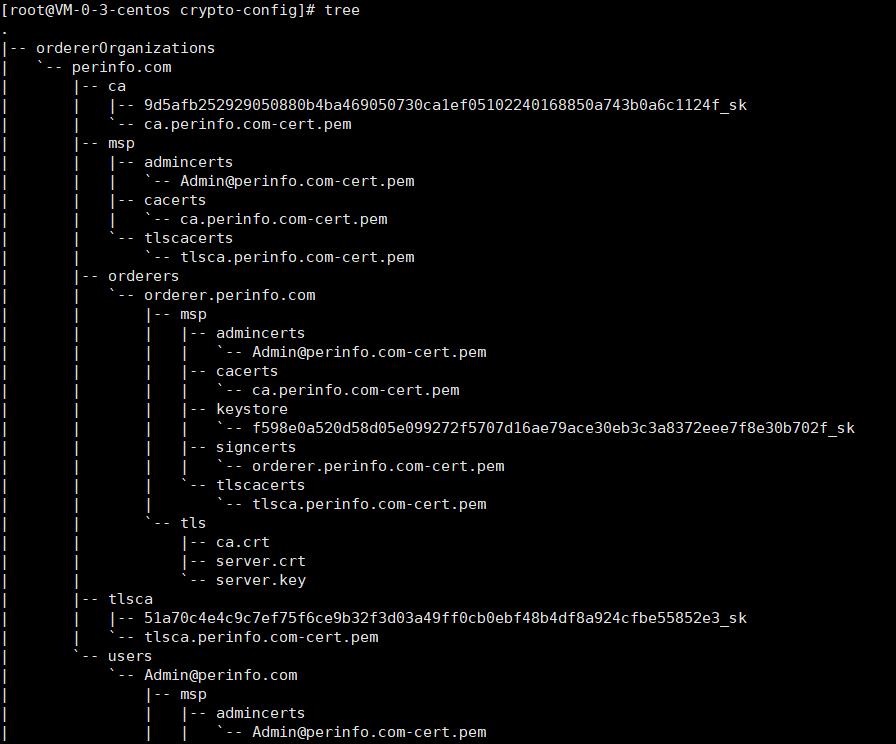
三、创世块的生成
fabric中channel就是账本,账本中的第一个区块需要手动生成
1、创建/channel-artifacts文件夹
2、编写configtx.yaml
看着多,实际上要改的很少
把/root/go/src/github.com/hyperledger/fabric/sampleconfig中的configtx.yaml文件拿过来修改
# Copyright IBM Corp. All Rights Reserved.
#
# SPDX-License-Identifier: Apache-2.0
#
---
################################################################################
#
# ORGANIZATIONS
#
# This section defines the organizational identities that can be referenced
# in the configuration profiles.
#
################################################################################
Organizations:
# SampleOrg defines an MSP using the sampleconfig. It should never be used
# in production but may be used as a template for other definitions.
- &OrdererOrg
# Name is the key by which this org will be referenced in channel
# configuration transactions.
# Name can include alphanumeric characters as well as dots and dashes.
Name: OrdererOrg
# ID is the key by which this org's MSP definition will be referenced.
# ID can include alphanumeric characters as well as dots and dashes.
ID: OrdererMSP
# MSPDir is the filesystem path which contains the MSP configuration.
MSPDir: crypto-config/ordererOrganizations/perinfo.com/msp
- &Org1
# DefaultOrg defines the organization which is used in the sampleconfig
# of the fabric.git development environment
Name: Org1MSP
# ID to load the MSP definition as
ID: Org1MSP
MSPDir: crypto-config/peerOrganizations/org1.perinfo.com/msp
AnchorPeers:
# AnchorPeers defines the location of peers which can be used
# for cross org gossip communication. Note, this value is only
# encoded in the genesis block in the Application section context
- Host: peer0.org1.perinfo.com
Port: 7051
- &Org2
# DefaultOrg defines the organization which is used in the sampleconfig
# of the fabric.git development environment
Name: Org2MSP
# ID to load the MSP definition as
ID: Org2MSP
MSPDir: crypto-config/peerOrganizations/org2.perinfo.com/msp
AnchorPeers:
# AnchorPeers defines the location of peers which can be used
# for cross org gossip communication. Note, this value is only
# encoded in the genesis block in the Application section context
- Host: peer0.org2.perinfo.com
Port: 7051
- &Org3
# DefaultOrg defines the organization which is used in the sampleconfig
# of the fabric.git development environment
Name: Org3MSP
# ID to load the MSP definition as
ID: Org3MSP
MSPDir: crypto-config/peerOrganizations/org3.perinfo.com/msp
AnchorPeers:
# AnchorPeers defines the location of peers which can be used
# for cross org gossip communication. Note, this value is only
# encoded in the genesis block in the Application section context
- Host: peer0.org3.perinfo.com
Port: 7051
- &Org4
# DefaultOrg defines the organization which is used in the sampleconfig
# of the fabric.git development environment
Name: Org4MSP
# ID to load the MSP definition as
ID: Org4MSP
MSPDir: crypto-config/peerOrganizations/org4.perinfo.com/msp
AnchorPeers:
# AnchorPeers defines the location of peers which can be used
# for cross org gossip communication. Note, this value is only
# encoded in the genesis block in the Application section context
- Host: peer0.org4.perinfo.com
Port: 7051
################################################################################
#
# CAPABILITIES
#
# This section defines the capabilities of fabric network. This is a new
# concept as of v1.1.0 and should not be utilized in mixed networks with
# v1.0.x peers and orderers. Capabilities define features which must be
# present in a fabric binary for that binary to safely participate in the
# fabric network. For instance, if a new MSP type is added, newer binaries
# might recognize and validate the signatures from this type, while older
# binaries without this support would be unable to validate those
# transactions. This could lead to different versions of the fabric binaries
# having different world states. Instead, defining a capability for a channel
# informs those binaries without this capability that they must cease
# processing transactions until they have been upgraded. For v1.0.x if any
# capabilities are defined (including a map with all capabilities turned off)
# then the v1.0.x peer will deliberately crash.
#
################################################################################
Capabilities:
# Channel capabilities apply to both the orderers and the peers and must be
# supported by both.
# Set the value of the capability to true to require it.
# Note that setting a later Channel version capability to true will also
# implicitly set prior Channel version capabilities to true. There is no need
# to set each version capability to true (prior version capabilities remain
# in this sample only to provide the list of valid values).
Channel: &ChannelCapabilities
# V1.4.3 for Channel is a catchall flag for behavior which has been
# determined to be desired for all orderers and peers running at the v1.4.3
# level, but which would be incompatible with orderers and peers from
# prior releases.
# Prior to enabling V1.4.3 channel capabilities, ensure that all
# orderers and peers on a channel are at v1.4.3 or later.
V1_4_3: true
# V1.3 for Channel enables the new non-backwards compatible
# features and fixes of fabric v1.3
V1_3: false
# V1.1 for Channel enables the new non-backwards compatible
# features and fixes of fabric v1.1
V1_1: false
# Orderer capabilities apply only to the orderers, and may be safely
# used with prior release peers.
# Set the value of the capability to true to require it.
# Note that setting a later Orderer version capability to true will also
# implicitly set prior Orderer version capabilities to true. There is no need
# to set each version capability to true (prior version capabilities remain
# in this sample only to provide the list of valid values).
Orderer: &OrdererCapabilities
# V1.4.2 for Orderer is a catchall flag for behavior which has been
# determined to be desired for all orderers running at the v1.4.2
# level, but which would be incompatible with orderers from prior releases.
# Prior to enabling V1.4.2 orderer capabilities, ensure that all
# orderers on a channel are at v1.4.2 or later.
V1_4_2: true
# V1.1 for Orderer enables the new non-backwards compatible
# features and fixes of fabric v1.1
V1_1: false
# Application capabilities apply only to the peer network, and may be safely
# used with prior release orderers.
# Set the value of the capability to true to require it.
# Note that setting a later Application version capability to true will also
# implicitly set prior Application version capabilities to true. There is no need
# to set each version capability to true (prior version capabilities remain
# in this sample only to provide the list of valid values).
Application: &ApplicationCapabilities
# V1.4.2 for Application enables the new non-backwards compatible
# features and fixes of fabric v1.4.2
V1_4_2: true
# V1.3 for Application enables the new non-backwards compatible
# features and fixes of fabric v1.3.
V1_3: false
# V1.2 for Application enables the new non-backwards compatible
# features and fixes of fabric v1.2 (note, this need not be set if
# later version capabilities are set)
V1_2: false
# V1.1 for Application enables the new non-backwards compatible
# features and fixes of fabric v1.1 (note, this need not be set if
# later version capabilities are set).
V1_1: false
################################################################################
#
# APPLICATION
#
# This section defines the values to encode into a config transaction or
# genesis block for application-related parameters.
#
################################################################################
Application: &ApplicationDefaults
# Organizations lists the orgs participating on the application side of the
# network.
Organizations:
################################################################################
#
# ORDERER
#
# This section defines the values to encode into a config transaction or
# genesis block for orderer related parameters.
#
################################################################################
Orderer: &OrdererDefaults
# Orderer Type: The orderer implementation to start.
# Available types are "solo", "kafka" and "etcdraft".
OrdererType: solo
# Addresses used to be the list of orderer addresses that clients and peers
# could connect to. However, this does not allow clients to associate orderer
# addresses and orderer organizations which can be useful for things such
# as TLS validation. The preferred way to specify orderer addresses is now
# to include the OrdererEndpoints item in your org definition
Addresses:
- orderer.perinfo.com:7050
# Batch Timeout: The amount of time to wait before creating a batch.
BatchTimeout: 2s
# Batch Size: Controls the number of messages batched into a block.
# The orderer views messages opaquely, but typically, messages may
# be considered to be Fabric transactions. The 'batch' is the group
# of messages in the 'data' field of the block. Blocks will be a few kb
# larger than the batch size, when signatures, hashes, and other metadata
# is applied.
BatchSize:
# Max Message Count: The maximum number of messages to permit in a
# batch. No block will contain more than this number of messages.
MaxMessageCount: 10
# Absolute Max Bytes: The absolute maximum number of bytes allowed for
# the serialized messages in a batch. The maximum block size is this value
# plus the size of the associated metadata (usually a few KB depending
# upon the size of the signing identities). Any transaction larger than
# this value will be rejected by ordering. If the "kafka" OrdererType is
# selected, set 'message.max.bytes' and 'replica.fetch.max.bytes' on
# the Kafka brokers to a value that is larger than this one.
AbsoluteMaxBytes: 99 MB
# Preferred Max Bytes: The preferred maximum number of bytes allowed
# for the serialized messages in a batch. Roughly, this field may be considered
# the best effort maximum size of a batch. A batch will fill with messages
# until this size is reached (or the max message count, or batch timeout is
# exceeded). If adding a new message to the batch would cause the batch to
# exceed the preferred max bytes, then the current batch is closed and written
# to a block, and a new batch containing the new message is created. If a
# message larger than the preferred max bytes is received, then its batch
# will contain only that message. Because messages may be larger than
# preferred max bytes (up to AbsoluteMaxBytes), some batches may exceed
# the preferred max bytes, but will always contain exactly one transaction.
PreferredMaxBytes: 512 KB
# Max Channels is the maximum number of channels to allow on the ordering
# network. When set to 0, this implies no maximum number of channels.
MaxChannels: 0
Kafka:
# Brokers: A list of Kafka brokers to which the orderer connects. Edit
# this list to identify the brokers of the ordering service.
# NOTE: Use IP:port notation.
Brokers:
- 127.0.0.1:9092
# Organizations lists the orgs participating on the orderer side of the
# network.
Organizations:
################################################################################
#
# PROFILES
#
# Different configuration profiles may be encoded here to be specified as
# parameters to the configtxgen tool. The profiles which specify consortiums
# are to be used for generating the orderer genesis block. With the correct
# consortium members defined in the orderer genesis block, channel creation
# requests may be generated with only the org member names and a consortium
# name.
#
################################################################################
Profiles:
FourOrgsOrdererGenesis:
Capabilities:
<<: *ChannelCapabilities
Orderer:
<<: *OrdererDefaults
Organizations:
- *OrdererOrg
Capabilities:
<<: *OrdererCapabilities
Consortiums:
SampleConsortium:
Organizations:
- *Org1
- *Org2
- *Org3
- *Org4
FourOrgsChannel:
Consortium: SampleConsortium
Application:
<<: *ApplicationDefaults
Organizations:
- *Org1
- *Org2
- *Org3
- *Org4
Capabilities:
<<: *ApplicationCapabilities
3、创建系统创始区块
该创始区块属于节点
export FABRIC_CFG_PATH=$PWD
configtxgen -profile FourOrgsOrdererGenesis -outputBlock channel-artifacts/genesis.block
注意:
FourOrgsOrdererGenesis 是你自己在configtx.yaml中设置的profile名

生成了创始区块

4、创建账本创始区块
该创始区块属于channel账本
configtxgen -profile FourOrgsChannel -outputCreateChannelTx channel-artifacts/channel.tx -channelID mychannel
5、为通道内的两个组织创建锚节点初始化文件
configtxgen -profile FourOrgsChannel -outputAnchorPeersUpdate channel-artifacts/Org1MSPanchors.tx -channelID mychannel -asOrg Org1MSP
configtxgen -profile FourOrgsChannel -outputAnchorPeersUpdate channel-artifacts/Org2MSPanchors.tx -channelID mychannel -asOrg Org2MSP
configtxgen -profile FourOrgsChannel -outputAnchorPeersUpdate channel-artifacts/Org3MSPanchors.tx -channelID mychannel -asOrg Org3MSP
configtxgen -profile FourOrgsChannel -outputAnchorPeersUpdate channel-artifacts/Org4MSPanchors.tx -channelID mychannel -asOrg Org4MSP
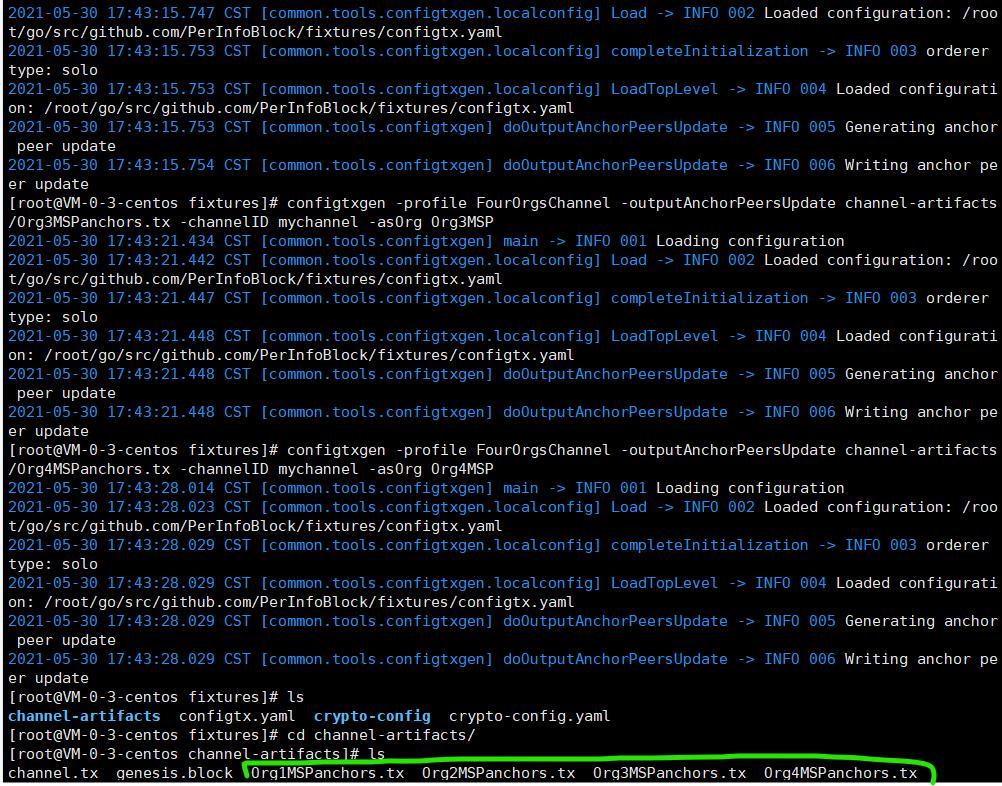
四、fabric-ca的编译和安装
由于之前安装fabric是已经安装了,此处省略,建议直接去下载官方二进制文件,自己编译容易出错
查看fabric-ca-server version时报错:(版本问题)
问题:
/lib64/libc.so.6: version `GLIBC_2.28' not found (required by fabric-ca-server)
这个原因我没有找到,我使用的是腾讯云服务器,libc初始版本为2.17,不过解决方法倒是找到了
解决方法:
冒着系统掉头的风险升级libc.so.6(其实就是更换软链接)
== 这里一定要在root用户权限下进行 == !!!!
① 升级gcc到最新版本
②升级make
wget http://ftp.gnu.org/gnu/make/make-4.2.tar.gz
tar -xzvf make-4.2.tar.gz
cd make-4.2
sudo ./configure
sudo make
sudo make install
sudo rm -rf /usr/bin/make
sudo cp ./make /usr/bin/
make -v
③安装glibc-2.28
curl -O http://ftp.gnu.org/gnu/glibc/glibc-2.28.tar.gz
tar zxf glibc-2.28.tar.gz
my glibc-2.28 /opt
cd /opt/glibc-2.28/
mkdir build
cd build/
../configure --prefix=/usr --disable-profile --enable-add-ons --with-headers=/usr/include --with-binutils=/usr/bin
make -j8
make install
会有报错,但是可以忽略,make会很久很久(胆战心惊.jpg)

④ 重新做个软链接 (这里一定要root用户啊啊啊!!!!)
cd /lib64
rm -rf libm.so.6
ln -s libm-2.28.so libm.so.6
查看glibc版本
ldd --version

现在查看fabric-ca-sever和fabric-ca-client的版本
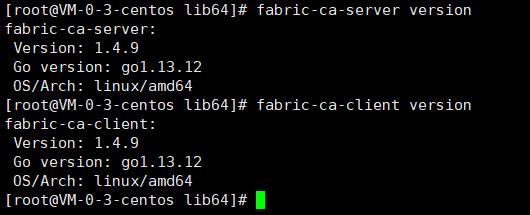
成功了!!!
五、fabric-ca-server的初始化
因为这台服务器上还没有对fabric-ca-server进行初始化,故如下进行:
1、创建文件夹
mkdir -p /etc/hyperledger/fabric-ca-server
cd /etc/hyperledger/fabric-ca-server
2、初始化fabric-ca-server
fabric-ca-server init -b admin:adminpw #adminpw是你自己设置的密码
然后会对fabric-ca-server进行初始化
(忽略我截图里面的歌词哈哈,才看到)
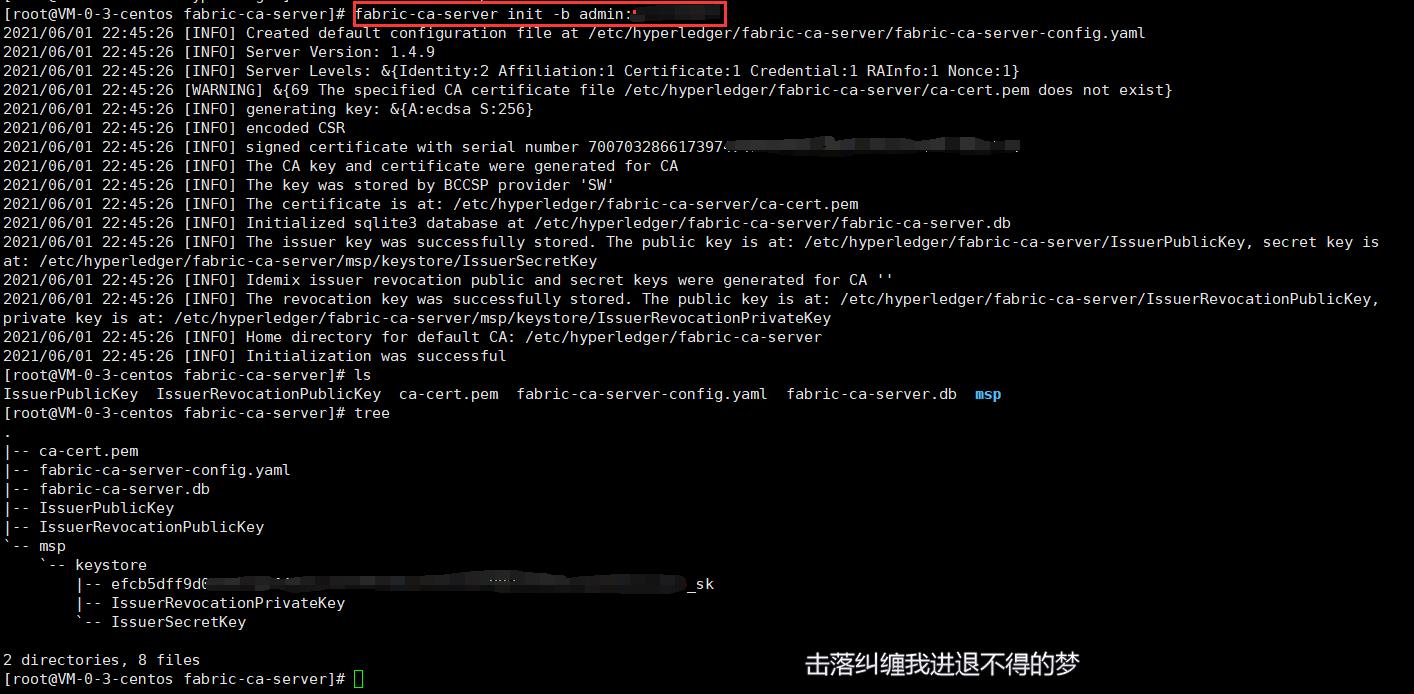
文件结构为:
.
|-- ca-cert.pem
|-- fabric-ca-server-config.yaml
|-- fabric-ca-server.db
|-- IssuerPublicKey
|-- IssuerRevocationPublicKey
`-- msp
`-- keystore
|-- efcb5dff9dxxxxxxxxxxxxxxxxxxxxxxxbcb_sk
|-- IssuerRevocationPrivateKey
`-- IssuerSecretKey
其中:
(1)fabric-ca-server-config.yaml :配置文件
(2)fabric-ca-server.db:数据库文件(数据库选择sqlite3时有效)
(3)ca-cert.pem:证书文件
(4)msp:私钥文件
3、按照需求修改配置文件
其中fabric-ca-server.config.yaml中的数据库配置:
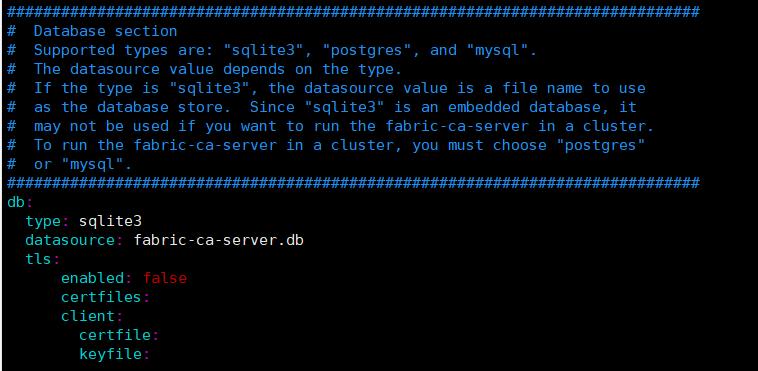
db部分的配置中,选择不同的数据库服务器配置格式是不一样的,同时fabric-ca本身不会安装这些数据库,需要你自己提前安装好。
①sqlite3:
type: sqlite3
datasource: fabric-ca-server.db
②mysql:
type: sqlite3
datasource: root:rootpw@tcp(localhost:3306)/fabric_ca?parseTime=True&tls=custom
4、fabric-ca-server的启动

因为没有写前端,将就看哈哈,启动成功!

六、fabric-ca-client
常用功能:
(1)注册新账号
(2)载入账号信息
(3)获取CA服务器的证书
七、将fabric-ca-server绑定到现有项目中
1、将fabric-ca-server绑定到现有组织中
找到fabric-ca-server.yaml中的
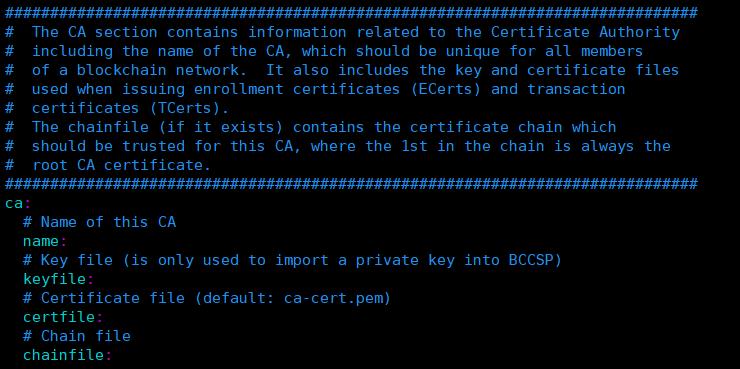
ca:
# Name of this CA
name:
# Key file (is only used to import a private key into BCCSP)
keyfile:
# Certificate file (default: ca-cert.pem)
certfile:
# Chain file
chainfile:
然后进入项目中存放org1相关证书的文件夹中
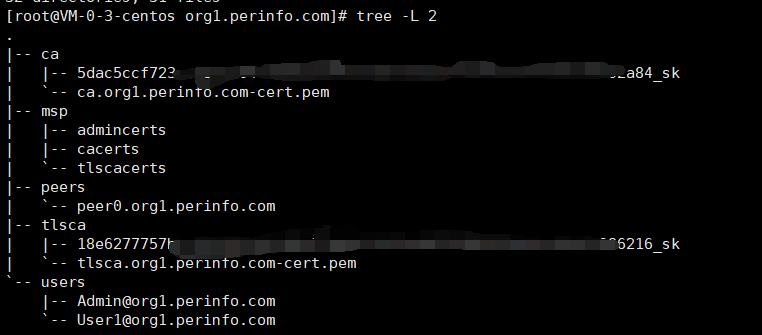
所以可以将fabric-ca-server-config.yaml中的ca修改了
ca:
# Name of this CA
name:ca-org1
# Key file (is only used to import a private key into BCCSP)
keyfile:/root/go/src/github.com/PerInfoChain/fixtures/crypto-config/peerOrganizations/org1.perinfo.com/ca/5dac5cxxxxxxx4_sk
# Certificate file (default: ca-cert.pem)
certfile:/root/go/src/github.com/PerInfoChain/fixtures/crypto-config/peerOrganizations/org1.perinfo.com/ca/ca.org1.perinfo.com-cert.pem
# Chain file
chainfile:ca.org1.perinfo.com-cert.pem
以上是关于Fabric1.4 搭建区块链网络的主要内容,如果未能解决你的问题,请参考以下文章